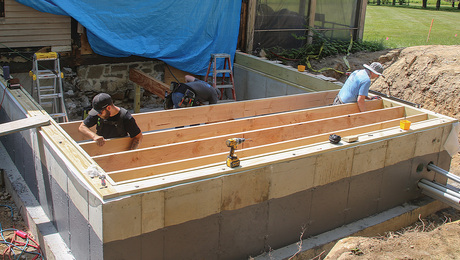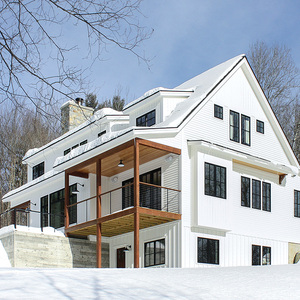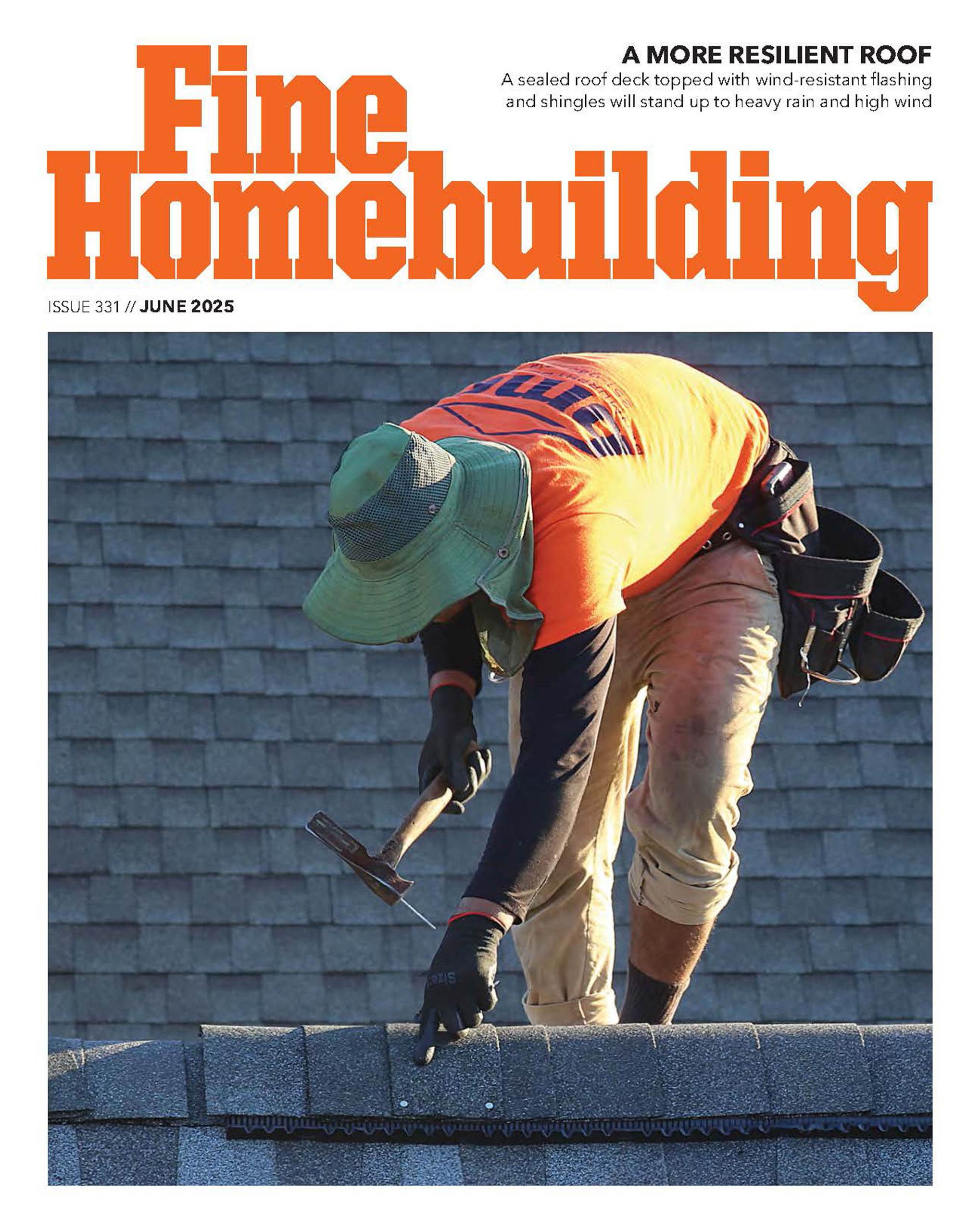I am building a new house and asked my plumber to make certain to minimize the number of sewer vent penetrations as much as possible. The house has two bathrooms and a utility room where this really becomes a concern. I anticipated that he would tie all vents into one penetration for each room. Instead, he took the individual vents straight out the roof with one exception where he joined the bathtub and shower vents in the master bath.
What are the general rules/codes for combining sewer vents so that you can minimize penetrations? When I asked him, he told me that based on the two baths and separate utility room that I needed a minimum of four 1 1/2″ and two 2″ vent stacks.
Thanks for any help.



















Replies
Cisco-
You should fill out your profile so that people can tell where you are from as codes vary from place to place.
The IRC2000 requires only one main vent, either a stack vent or vent stack (the difference between the two is lost on me, perhaps someone else can elucidate this topic). P3102 is the section of code to look at if the IRC is used in your neck of the woods. All other vents can be terminated with an AAV.
Z
The house is located in Central Texas, outside any incorporated areas and there are no code requirements for plumbing in this area. I would like to keep the construction up to the IRC2000 code you mentioned.Thanks,Scott
All of those could have been tied together into one vent below the roof, as long as slope was maintained. Your plumber would have had to use more fittings and more short pieces of pipe, but he probably could have done it.
The roof is not yet on, so I will redo it myself to minimize the penetrations. How much slope should I keep? In case it matters, he used mostly 1 1/2" pipe with 2" on the toilets.Scott
To correctly size vents you need to take into account the fixtures that are being vented together. Easiest thing to do is to buy the "Code Check -- Plumbing" guide and use their tables, which have UPC and IRC reqs. You could also buy the IRC and use the tables in there. I would not be surprised if you can get the entire house on one 4" vent thru the roof. What size is the sewer line leaving the house?
I believe the sewer line exiting the house is 4".
Then you need 4" thru the roof. That's usually enough for all of the house fixtures to share.
If you have your IRC or code check handy, check the size vents required for the toilets.
2" for a single water closet may be ok, but like you said, not normal. I think countint the fixture units for drains and vent sizes is spelled out pretty clearly in Code Check Plumbing.
Dave
As far as I've ever known, and done, a 2" vent will serve a toilet/vanity/shower just fine.
Thanks to all -- I will check the books I have access to tonight. I just wanted to make certain that I was not totally off base. The person doing the work tried to tell me that what he did was required by code without being too specific. I though he was just taking the cheap/easy way out even though I made my desires very clear. Sounds like I was right!
I second the "code check" recommendation - it caught 3 or 4 easily fixed issues in my designs prior to inspection that saved me HOURS. Very, very useful.
it is possible to tie them all together from a physics perspective as the person above me stated ... 3 x 2" still has a smaller surface area than one 4". 'Zall good.
Now, holes with the proper flashing are fine, but if you want to spend your time and effort to improve the look of your roof then go for it. Remember though that you are doing this purely for aesthetics. A downside is making it harder to snake the individual systems from the vent if you need to. I hadn't considered this before until I really needed to do it in the last house.
Inspectors in my area don't like AAV's and neither do I for the aforementioned infrastructure support issue (read: snaking drains). I did use one on my Kitchen w/a garden window though recently.
Edited 12/18/2007 12:14 pm ET by BradG
A downside is making it harder to snake the individual systems from the vent if you need to. I hadn't considered this before until I really needed to do it in the last house.all my bathroom are on the outside wall, so om each vent pipe. I have a sweep T go out to the wall for clean outs. just for that reason, and the vent above the wall tie into one in the attic and then exit as 1 4 inch
Why not just go back to the plumber and ask for his explanation of why he did what he did and remind him of your desire to minimize the roof penetrations?
Not a plumber.
I think DavidMeiland has it right - but still check out the books you have.
The 4" vent stack will look like a porcupine in the attic - but who cares?
RE: slope for vent lines - 1/4" per foot is fine - the only thing they drain is rain water which falls into the vent stack. Just need to make sure there are not any low spots which could fill with rainwater and form a "trap" in the vent line.
6 vent stacks sounds excessive for your situation - two 3" maybe depending on the location of the two bathrooms. This may work out better depending on locations for the bathrooms.
Jim
I got one 4 inch for everything
Simple rule.
What comes in must equal what goes out.
4" waste pipe means a 4" vent stack or the combined cross sectional area of all the vents.
I don't plumb houses for a living, but have consulted on more than I care to remember. I don't like roof penitrations, cause that's a place a leak will start----- more vents equal more chances of a leak.
"Why do you hurt me when I do bad things to you?" My youngest son to his older brother
>>4" waste pipe means a 4" vent stack or the combined cross sectional area of all the vents.<<
I finally did the math and this is exactly what the plumber has installed with a very slight overage in vent area.
>>...minimum of four 1-1/2" and two 2" vent stacks.<< - from cisco's OP.
Cross sectional areas: 4" = 12.57 sq in; 3" = 7.01 sq in; 2" = 3.14 sq in; 1-1/2" = 1.77 sq in.
(4 x 1.77) + (2 x 3.14) = 7.08 + 6.28 = 13.36 combined vent area > 12.57 area of 4" drain line. Vent area "overage" = 0.79 sq in
I think I would have gone with two 3" vent lines through the roof to minimize roof penetrations per cisco's wishes. 2 x 7.01 = 14.02 sq in vent > 12.57 sq in drain. Essentially one 3" for each bathroom with the utility and kitchen tied into one or the other in the attic.
I think it really comes down to the plumber taking the easier / cheaper route to vent the system with no regard for cisco's request to minimize roof penetrations.
Jim Never underestimate the value of a sharp pencil or good light.
Perhaps. But without knowing the size of the house, distance between fixtures, height of attic area, and whether or not there are cathedral ceiling areas that make it impossible to combine vents it is all guess work from here. There is more to it then just saying combine all the vents into one.
They can't get your Goat if you don't tell them where it is hidden.
But it's a no-brainer to combine the vents for a single bathroom.
If your view never changes you're following the wrong leader
You are correct , assuming it is physically possible. My post simply was to make the point that it isn't always physically possible to combine vents. Most plumbers I have worked around try hard to minimize roof penetrations.
They can't get your Goat if you don't tell them where it is hidden.
I've been a licensed plumber in NC for 20 years. In the old days we piped everything out a 3" stack regardless of the size of the building sewer. New code we need one 2" vent near the point of maximum flow (main stack) and we can use air admittance valves everywhere else. Codes change every year and we don't put the air admittance valves (studor vents) on until the house has been water tested and all glue fumes are out of the system. But we can and have legally vented an entire house with a single 2" vent.
I don't really trust studorvents so I minimize them and generally ahve two or three 2" vents per house. but it would be perfectly legal to have one.
M
------------------
"You cannot work hard enough to make up for a sloppy estimate."
Like SN said, 95% of the houses I build these days have two 2" vents, and most are 2.5 baths. Some of it depends on how closely the kitch/baths/laundry are located. As far as having more than one vent per bath - your guy is a novice.... Seasoned plumbers are looking to fully meet code requirements without wasting materials.
Ya gotta wonder what else the guy screwed up.
Maybe he's just a cheapskate. The basic 1-1/2" and 2" elbows and tees are the cheapest. The 3x2 and 4x3 stuff starts costing more, and you have to remember to bring it along. Plus you might need more pipe to bring everything together. And it would take more time.
I am relieved to hear that I don't need eight vents out the roof for only two bathrooms and a utility room (washer & sink). Due to the baths being on opposite sides of the house I will probably keep at least two penetrations and possibly a third for the utility room but will try for two.The plumber I hired has been doing this for a long time and came with good recommendations but since many people building new homes don't know much about plumbing they cannot really tell you much about the end product; only that the job was completed on time and for the initial estimate. Looks like I will be doing more plumbing than I had planned on but I like the supply-side work anyway, just difficult to work full time and build you own house with a construction loan schedule. Scott
Yeah, and the roofer has to pay for the jacks.
If your view never changes you're following the wrong leader
I'm also building a house which is outside of any code check. I'm taking the advice of Rex Cauldwell who published a book through Taunton's on plumbing. He is a believer in AAV's. I'm using Studor vents to achieve my venting with no roof penetrations. My guess to why your plumber didn't go that route is they are 20+ a piece.
The problem with AAVs is that they aren't totally reliable. They do fail. The good news is that when they start malfunctioning, there isn't any Q - to the informed, - what the prob is. Sometimes AAVs are necessary - like with an island sink. My instructions to my plumber are - minimize roof penetrations, all have to be on the back roof plane, and AAVs are only used when there is no other choice.
So how does the air escape when you introduce water into the waste system?
"Why do you hurt me when I do bad things to you?" My youngest son to his older brother
If the job was bid, his assumption is it's going to be built according to customs and common practices of the profession, in addition to meeting basic building codes. Combining vents isn't normally done unless it's the cheapest/fastest route.
What you're asking for takes long and costs more money, which isn't typically covered in a bid unless it's spelled out up front.
My guess is you'll have to pay for the additional work if you want a plumber to do it as part of the bid, if it wasn't in there to begin with.
Cheers
Beer was created so carpenters wouldn't rule the world.
>> Combining vents isn't normally done unless it's the cheapest/fastest route. <<
and here anyway, it is normally "the cheapest/fastest route. " and therefore is done on most all houses. I don't know what they do in Texas though.
A good thing for the OP to do would be to simply ride around and look at some new (or newish) houses in his area and see how many vents he sees.